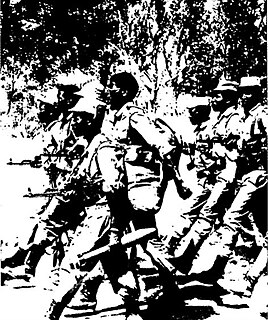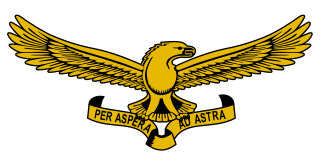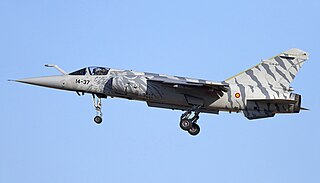
Operation Reindeer, which began on 4 May 1978, was South Africa's second major military operation in Angola, carried out under the Apartheid regime, the first being Operation Savannah.

The Battle of Cassinga, Cassinga Raid or Kassinga Massacre was a controversial South African airborne attack on a South West Africa People's Organization (SWAPO) military base at the former town of Cassinga, Angola on the 4 May 1978. Conducted as one of the three major actions of Operation Reindeer during the South African Border War, it was the South African Army’s first major air assault.

The South West Africa Territorial Force (SWATF) was an auxiliary arm of the South African Defence Force (SADF) and comprised the armed forces of South West Africa from 1977 to 1989. It emerged as a product of South Africa's political control of the territory which was granted to the former as a League of Nations mandate following World War I.

61 Mechanised Battalion Group was a unit of the South African Infantry Corps; although it was classed as mechanized infantry, it was a combined arms force consisting of infantry, armour and artillery.
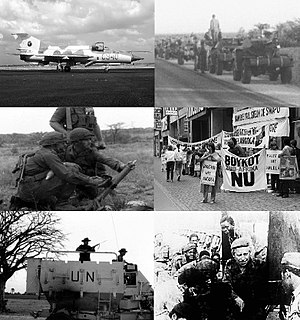
The South African Border War, also known as the Namibian War of Independence, and sometimes denoted in South Africa as the Angolan Bush War, was a largely asymmetric conflict that occurred in Namibia, Zambia, and Angola from 26 August 1966 to 21 March 1990. It was fought between the South African Defence Force (SADF) and the People's Liberation Army of Namibia (PLAN), an armed wing of the South West African People's Organisation (SWAPO). The South African Border War resulted in some of the largest battles on the African continent since World War II and was closely intertwined with the Angolan Civil War.

Operation Askari was a military operation during 1983 in Angola by the South African Defence Force (SADF) during the South African Border War and Angolan Civil War.

Operation Wallpaper was a military operation by the South African Defence Force (SADF) during the Angolan Civil War and South African Border War.

Operation Moduler was a military operation by the South African Defence Force (SADF) during the South African Border War. It formed part of what has come to be called the Battle of Cuito Cuanavale. The Angolan objective was to advance south-east to attack the UNITA at Mavinga. The SADF objective was to protect UNITA by stopping that advance. The advance was halted with heavy Angolan casualties. The South African forces and its UNITA allies then began offensive operations against the Angolan forces, who had retreated back to a defensive line east of the Cuito River with the objective of destroying them once and for all.
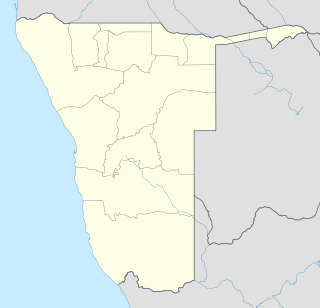
Operation Prone was a proposed military operation by the South African Defence Force (SADF) and South West African Territorial Force (SWATF) during the South African Border War and Angolan Civil War between May and September 1988. With the advance of the 50th Cuban Division towards Calueque and the South-West Africa border, the SADF formed the 10 SA Division to counter this threat. The plan for Operation Prone had two phases. Operation Linger was to be a counterinsurgency phase and Operation Pact a conventional phase.

Operation Sceptic was the largest anti-South West Africa People's Organization (SWAPO) sweep during the South African Border War up to that point. The operation was also known as Smokeshell though this was the codename for the People's Liberation Army of Namibia (PLAN) base which was the main focus of the attack. This operation followed Operation Safraan and preceded Operation Klipklop.

44 Parachute Brigade was a parachute infantry brigade of the South African Army. It was founded on 20 April 1978, following the disbandment of 1 SA Corps. Upon formation, the brigade was commanded by Brigadier M. J. du Plessis, who was assigned the task of establishing the unit with the assistance of the Parachute Staff Officer, Colonel Jan Breytenbach. At the time du Plessis was the commanding officer of the Orange Free State Command and had previous experience serving in 1 Parachute Battalion. Breytenbach had also been a member of 1 Parachute Battalion and had also founded the South African Special Forces Brigade and 32 Battalion. The location that was chosen for the brigade's headquarters was in the lines of the OFS Cmd Headquarters, next to the old Tempe Airfield in Bloemfontein.

Operation Boswilger was a military operation executed by the South West Africa Territorial Force (SWATF) in June 1985 during the South African Border War and Angolan Civil War. The SADF soldiers pursued SWAPO's, PLAN insurgents, who had attacked infrastructure, out of South West Africa/Namibia across the border into Angola.

Operation Mebos occurred during July and August 1982 with the objective of attacking SWAPO's People's Liberation Army of Namibia (PLAN) bases and new regional headquarters in Southern Angola by the South African Defence Force (SADF) based in South West Africa/Namibia. The plan involved the use of South African Air Force helicopters flown from mobile helicopter administrative areas (HAA) with a SADF Tactical Headquarters deep in Angola and protected from possible People's Forces for the Liberation of Angola (FAPLA) attacks by 61 Mechanised Battalion. These helicopters would fly 32 Battalion and paratroopers from the HAA areas to SWAPO targets identified by reconnaissance teams deep in the Angolan bush and by signal and human intelligence.

Operation Excite/Hilti was a set of military operations by the South African Defence Force (SADF) during the Angolan Civil War and South African Border War.

Operation Firewood was a secretive military operation in 1987 by the South African Defence Force (SADF) during the South African Border War.

Operation Merlyn was a military operation by the South African Defence Force (SADF), South West African Territorial Force (SWATF) and South West African Police (SWAPOL) during the South African Border War and Angolan Civil War in April 1989. The aim of the operation was to prevent the incursion of PLAN (SWAPO) insurgents into South West Africa/Namibia from bases in Angola. These incursions were in violation of a ceasefire which came into effect on 1 April 1989 via the implementation of United Nations Security Council Resolution 435 and the Tripartite Accord. Initially, these PLAN incursions were tackled by South West African police units and eventually by SADF and SWATF units, released to assist the police having been confined to their bases by the peace agreements. These incursions and the conflict that occurred ended after hastily arranged talks resulted in the Mount Etjo Declaration and an eventual ceasefire.

8 South African Infantry Battalion is a mechanized infantry unit of the South African Army. The battalion is equipped with Ratel Infantry Fighting Vehicles (IFV) used for fast transport and combat mobility across rough ground. Support weapons for mechanized infantry are also provided with motorized transport, or are built directly into these IFVs, in order to keep pace with the IFVs in combat. The battalion was raised at Upington in the Northern Cape in 1973, and assigned to the Infantry Formation.

Operation Magneto was a military operation in August 1985 to transport UNITA soldiers by the South African Defence Force (SADF) during the Angolan Civil War and South African Border War.

South West Africa Command was a command of the South African Army.




